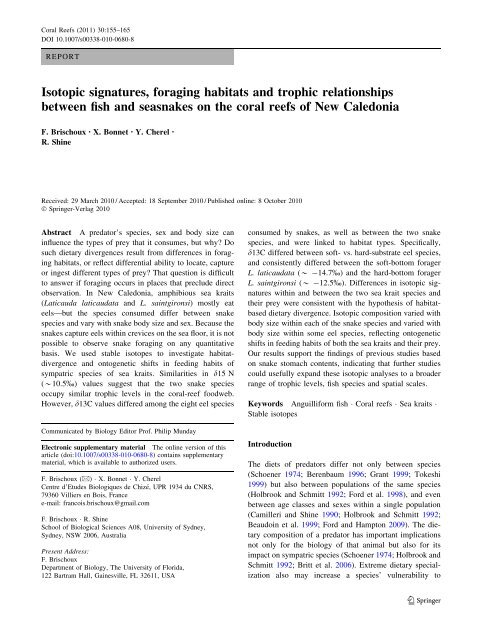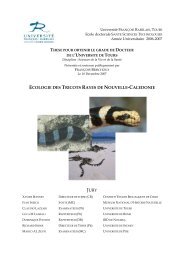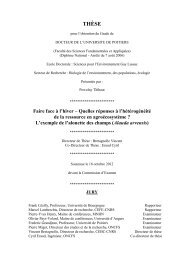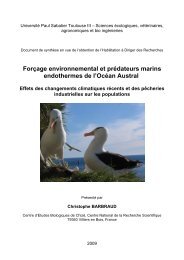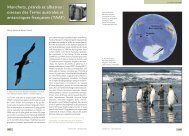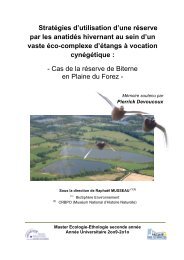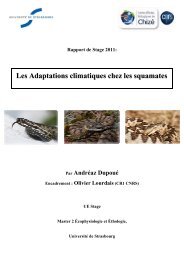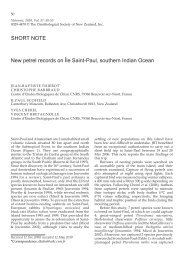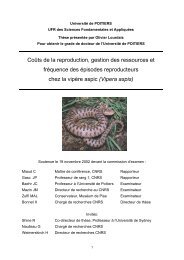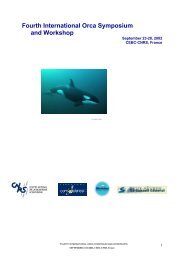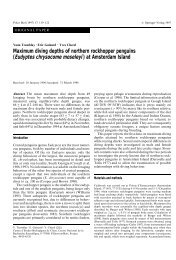Isotopic signatures, foraging habitats and trophic ... - Cebc - CNRS
Isotopic signatures, foraging habitats and trophic ... - Cebc - CNRS
Isotopic signatures, foraging habitats and trophic ... - Cebc - CNRS
Create successful ePaper yourself
Turn your PDF publications into a flip-book with our unique Google optimized e-Paper software.
Coral Reefs (2011) 30:155–165<br />
DOI 10.1007/s00338-010-0680-8<br />
REPORT<br />
<strong>Isotopic</strong> <strong>signatures</strong>, <strong>foraging</strong> <strong>habitats</strong> <strong>and</strong> <strong>trophic</strong> relationships<br />
between fish <strong>and</strong> seasnakes on the coral reefs of New Caledonia<br />
F. Brischoux • X. Bonnet • Y. Cherel •<br />
R. Shine<br />
Received: 29 March 2010 / Accepted: 18 September 2010 / Published online: 8 October 2010<br />
Ó Springer-Verlag 2010<br />
Abstract A predator’s species, sex <strong>and</strong> body size can<br />
influence the types of prey that it consumes, but why? Do<br />
such dietary divergences result from differences in <strong>foraging</strong><br />
<strong>habitats</strong>, or reflect differential ability to locate, capture<br />
or ingest different types of prey? That question is difficult<br />
to answer if <strong>foraging</strong> occurs in places that preclude direct<br />
observation. In New Caledonia, amphibious sea kraits<br />
(Laticauda laticaudata <strong>and</strong> L. saintgironsi) mostly eat<br />
eels—but the species consumed differ between snake<br />
species <strong>and</strong> vary with snake body size <strong>and</strong> sex. Because the<br />
snakes capture eels within crevices on the sea floor, it is not<br />
possible to observe snake <strong>foraging</strong> on any quantitative<br />
basis. We used stable isotopes to investigate habitatdivergence<br />
<strong>and</strong> ontogenetic shifts in feeding habits of<br />
sympatric species of sea kraits. Similarities in d15 N<br />
(*10.5%) values suggest that the two snake species<br />
occupy similar <strong>trophic</strong> levels in the coral-reef foodweb.<br />
However, d13C values differed among the eight eel species<br />
Communicated by Biology Editor Prof. Philip Munday<br />
Electronic supplementary material The online version of this<br />
article (doi:10.1007/s00338-010-0680-8) contains supplementary<br />
material, which is available to authorized users.<br />
F. Brischoux (&) X. Bonnet Y. Cherel<br />
Centre d’Etudes Biologiques de Chizé, UPR 1934 du <strong>CNRS</strong>,<br />
79360 Villiers en Bois, France<br />
e-mail: francois.brischoux@gmail.com<br />
F. Brischoux R. Shine<br />
School of Biological Sciences A08, University of Sydney,<br />
Sydney, NSW 2006, Australia<br />
Present Address:<br />
F. Brischoux<br />
Department of Biology, The University of Florida,<br />
122 Bartram Hall, Gainesville, FL 32611, USA<br />
consumed by snakes, as well as between the two snake<br />
species, <strong>and</strong> were linked to habitat types. Specifically,<br />
d13C differed between soft- vs. hard-substrate eel species,<br />
<strong>and</strong> consistently differed between the soft-bottom forager<br />
L. laticaudata (* -14.7%) <strong>and</strong> the hard-bottom forager<br />
L. saintgironsi (* -12.5%). Differences in isotopic <strong>signatures</strong><br />
within <strong>and</strong> between the two sea krait species <strong>and</strong><br />
their prey were consistent with the hypothesis of habitatbased<br />
dietary divergence. <strong>Isotopic</strong> composition varied with<br />
body size within each of the snake species <strong>and</strong> varied with<br />
body size within some eel species, reflecting ontogenetic<br />
shifts in feeding habits of both the sea kraits <strong>and</strong> their prey.<br />
Our results support the findings of previous studies based<br />
on snake stomach contents, indicating that further studies<br />
could usefully exp<strong>and</strong> these isotopic analyses to a broader<br />
range of <strong>trophic</strong> levels, fish species <strong>and</strong> spatial scales.<br />
Keywords Anguilliform fish Coral reefs Sea kraits<br />
Stable isotopes<br />
Introduction<br />
The diets of predators differ not only between species<br />
(Schoener 1974; Berenbaum 1996; Grant 1999; Tokeshi<br />
1999) but also between populations of the same species<br />
(Holbrook <strong>and</strong> Schmitt 1992; Ford et al. 1998), <strong>and</strong> even<br />
between age classes <strong>and</strong> sexes within a single population<br />
(Camilleri <strong>and</strong> Shine 1990; Holbrook <strong>and</strong> Schmitt 1992;<br />
Beaudoin et al. 1999; Ford <strong>and</strong> Hampton 2009). The dietary<br />
composition of a predator has important implications<br />
not only for the biology of that animal but also for its<br />
impact on sympatric species (Schoener 1974; Holbrook <strong>and</strong><br />
Schmitt 1992; Britt et al. 2006). Extreme dietary specialization<br />
also may increase a species’ vulnerability to<br />
123
156 Coral Reefs (2011) 30:155–165<br />
extinction (Van Valkenburgh et al. 2004) or result in<br />
complex coevolution between the predator <strong>and</strong> its prey<br />
(Reid 1991). Accordingly, considerable research has<br />
explored the reasons for dietary diversity (e.g., Schoener<br />
1971, 1974; Peckarsky 1982; Stephens <strong>and</strong> Krebs 1986;<br />
Greene 1986; Arnold 1993). That research has identified a<br />
range of ecological factors that can generate dietary<br />
divergence between any two predators: for example, a<br />
predator’s body size <strong>and</strong> shape may influence the<br />
feasibility of alternative <strong>foraging</strong> modes, e.g., ambush vs.<br />
wide-<strong>foraging</strong> (Secor 1995), its ability to locate, capture,<br />
overpower <strong>and</strong> ingest prey (Mittelbach 1981) or its ability<br />
to cope with toxins in the prey (Phillips <strong>and</strong> Shine 2005).<br />
Alternatively, different predators may forage in different<br />
<strong>habitats</strong> <strong>and</strong> hence encounter a different range of prey taxa<br />
(Holbrook <strong>and</strong> Schmitt 1992). In practice, many of these<br />
factors interact; for example, a predator unable to capture<br />
or ingest a large prey type will likely forage in <strong>habitats</strong> that<br />
maximize encounter rates with smaller (<strong>and</strong> thus, potentially<br />
edible) prey instead (Schoener 1971; Stephens <strong>and</strong><br />
Krebs 1986; Arnold 1993).<br />
Teasing apart the determinants of diet composition in<br />
predators is a challenging task, because of these multiple<br />
potential (<strong>and</strong> non-exclusive) mechanistic pathways. The<br />
task is simplified in systems that contain a suite of sympatric<br />
predators that differ in diets but are broadly similar<br />
in morphology, ecology <strong>and</strong> behavior—such as congeneric<br />
species, or age <strong>and</strong> sex classes within a single predator<br />
species. Because all of these animals potentially are<br />
exposed to the same suite of available prey, differences in<br />
dietary composition among <strong>and</strong> within species must be due<br />
to the kinds of factors identified above. In systems that<br />
facilitate direct observation of predator–prey encounters,<br />
we can evaluate issues such as <strong>foraging</strong> habitat use <strong>and</strong><br />
prey-h<strong>and</strong>ling ability. In most systems, however, encounters<br />
between predators <strong>and</strong> prey occur in situations (at<br />
night, inside shelter sites, etc.), where direct observation is<br />
impossible. Even if some encounters can be observed, they<br />
may well be a non-r<strong>and</strong>om sample of all predator–prey<br />
encounters. Thus, to robustly test hypotheses about niche<br />
partitioning in sympatric predators, we need objective<br />
methods to identify hard-to-measure variables, such as the<br />
<strong>habitats</strong> in which prey are captured <strong>and</strong> consumed. Stableisotope<br />
technology offers promise in this respect.<br />
Measuring the isotopic niche of animals provides<br />
information complementary to conventional data on <strong>foraging</strong><br />
ecology (Peterson <strong>and</strong> Fry 1987; Newsome et al.<br />
2007). The concept of the isotopic niche is based on the<br />
fact that an animal’s chemical composition is influenced by<br />
what it consumes (Fry 2006). For example, consumers are<br />
enriched in 15 N relative to their food, <strong>and</strong> consequently<br />
stable nitrogen-isotope measurements (d 15 N) can indicate<br />
<strong>trophic</strong> position (V<strong>and</strong>erklift <strong>and</strong> Ponsard 2003). In<br />
123<br />
contrast, stable carbon <strong>signatures</strong> (d 13 C) vary little along<br />
the food chain, <strong>and</strong> in the marine environment, d 13 C values<br />
often depend on <strong>foraging</strong> <strong>habitats</strong> (Cherel <strong>and</strong> Hobson<br />
2007; Cherel et al. 2007). Typically, d 13 C varies among<br />
specific producers, <strong>and</strong> we can use this parameter to<br />
examine differences in <strong>trophic</strong> support. Because identification<br />
<strong>and</strong> examination of the producers is often difficult,<br />
d 13 C of prey are used as a proxy for particular production<br />
sources <strong>and</strong> thus presumably <strong>habitats</strong> (Cherel <strong>and</strong> Hobson<br />
2007; Cherel et al. 2007). Stable-isotope <strong>signatures</strong> can<br />
thus be used to evaluate variations in <strong>trophic</strong> positions <strong>and</strong><br />
<strong>foraging</strong> <strong>habitats</strong> as a function of predator species, sex <strong>and</strong><br />
size in a system where prey-type partitioning plausibly<br />
reflects habitat-type partitioning (Cherel et al. 2008; Suryan<br />
<strong>and</strong> Fischer 2010).<br />
We used stable-isotope technology to test hypotheses<br />
that seek to explain diversity in dietary composition within<br />
<strong>and</strong> between sympatric species of amphibious seasnakes<br />
(sea kraits). Many snakes have specialized diets that differ<br />
not only between sympatric congeneric taxa but also<br />
depend on sex <strong>and</strong> body size within a species (Arnold<br />
1993). Some of the most clear-cut examples occur in<br />
aquatic snakes (e.g., North American natricines—Mushinsky<br />
et al. 1982; Australian acrochordid filesnakes—Shine<br />
1986, Houston <strong>and</strong> Shine 1993; Fijian sea kraits—Pernetta<br />
1977; Shetty <strong>and</strong> Shine 2002; Neo-Caledonian sea kraits—<br />
Brischoux et al. 2007b, 2009; hydrophiine seasnakes—<br />
Voris <strong>and</strong> Moffett 1981). In all these cases, females grow<br />
larger than conspecific males <strong>and</strong> consume larger species<br />
of fishes, <strong>and</strong> within a sex, a snake’s body size influences<br />
the species <strong>and</strong> size of prey that are consumed (Shine<br />
1991). The authors who have described these patterns<br />
generally have linked habitat divergence <strong>and</strong> intraspecific<br />
niche partitioning. For example, a snake’s body size may<br />
determine its ability to dive deep, for long periods<br />
(Brischoux et al. 2008)—<strong>and</strong> hence, larger snakes may take<br />
larger fishes because the latter are generally found in relatively<br />
deep water (Pernetta 1977; Shine 1986; Shine <strong>and</strong><br />
Shetty 2001; Shetty <strong>and</strong> Shine 2002). However, predator–<br />
prey encounters are difficult to observe in such places, so<br />
the habitat-divergence hypothesis is untestable using conventional<br />
observational methods.<br />
We aimed to test the habitat-divergence hypothesis in<br />
the Neo-Caledonian Lagoon using data on stable-isotope<br />
composition of two top-predator assemblages: sea kraits<br />
<strong>and</strong> their anguilliform fish prey. In New Caledonia, sea<br />
krait diets vary both inter-specifically (e.g., Laticauda<br />
laticaudata vs. L. saintgironsi; Brischoux et al. 2007b) <strong>and</strong><br />
ontogenetically within species, with L. laticaudata experiencing<br />
a wider niche shift in its diet with age than<br />
L. saintgironsi (Brischoux et al. 2009). In this study, we<br />
tested whether variation in stable-isotope composition of<br />
adult sea kraits was consistent with differences in feeding
Coral Reefs (2011) 30:155–165 157<br />
Fig. 1 Maps of our study sites.<br />
The panel in the upper-right<br />
corner indicates the general<br />
location of New Caledonia in<br />
the Western-Pacific. The main<br />
panel shows the South-West<br />
lagoon of New Caledonia. The<br />
panel in the lower-left corner<br />
shows the location of our<br />
sampling site for the current<br />
study (Signal Isl<strong>and</strong>, 22°17 0 45S;<br />
166°17 0 34E). Black areas<br />
indicate emergent l<strong>and</strong><br />
(mainl<strong>and</strong> <strong>and</strong> isl<strong>and</strong>s); gray<br />
areas represent coral-reef flats.<br />
The barrier reef <strong>and</strong> other<br />
fringing reefs are represented by<br />
light gray areas<br />
habits between <strong>and</strong> within species that have been suggested<br />
by previous studies based on stomach contents analysis <strong>and</strong><br />
broad prey habitat categorization (see Brischoux et al.<br />
2007b, 2009). Our rationale was to examine an independent<br />
data set (i.e., isotopic <strong>signatures</strong>) linked to the <strong>foraging</strong><br />
ecology of these top predators (both the sea kraits<br />
<strong>and</strong> their prey).<br />
In the present study, we use stable isotopes to test key<br />
hypotheses suggested by earlier studies. Specifically, we<br />
predict that (1) stable carbon isotopic <strong>signatures</strong> of the<br />
predators <strong>and</strong> their prey will vary according to <strong>foraging</strong><br />
<strong>habitats</strong> of the snakes (<strong>and</strong> thus <strong>foraging</strong> <strong>habitats</strong> <strong>and</strong>/or<br />
habitat use of their anguilliform prey), as predicted by the<br />
habitat-divergence hypothesis (Brischoux et al. 2007b) <strong>and</strong><br />
(2) the combination of stable nitrogen (representative of the<br />
<strong>trophic</strong> level) <strong>and</strong> stable carbon (presumably reflecting<br />
<strong>foraging</strong> habitat) isotopic <strong>signatures</strong> of the predators <strong>and</strong><br />
their prey will be related to predator body size, presumably<br />
reflecting ontogenetic shifts in feeding habits (Brischoux<br />
et al. 2009).<br />
Materials <strong>and</strong> methods<br />
Study species <strong>and</strong> area<br />
Sea kraits (Laticauda spp.) are proteroglyphous (frontfanged)<br />
snakes (Elapidae), widely distributed through<br />
tropical reefs (Heatwole 1999). Although they resemble<br />
‘‘true’’ seasnakes in specialized adaptations to marine life<br />
(e.g., flattened tail, salt-excreting gl<strong>and</strong>s), these snakes<br />
spend about half their time on l<strong>and</strong>. They forage in the<br />
water, but return to small islets to digest their prey, slough<br />
their skins, mate <strong>and</strong> lay eggs (Heatwole 1999). Two<br />
species of sea kraits occur in New Caledonia: Laticauda<br />
saintgironsi (Cogger <strong>and</strong> Heatwole 2006) <strong>and</strong> L. laticaudata<br />
(Saint Girons 1964; Ineich <strong>and</strong> Laboute 2002). Both<br />
species forage on the sea floor, exploring cavities <strong>and</strong><br />
burrows in search of anguilliform fish (Heatwole 1999;<br />
Brischoux <strong>and</strong> Bonnet 2009). Although we sampled 10<br />
islets, we concentrated most of our effort on Signal Isl<strong>and</strong><br />
(a 15-ha islet located in the southwest lagoon of New<br />
Caledonia; 22°17 0 45S; 166°17 0 34E, Brischoux <strong>and</strong> Bonnet<br />
2009, Fig. 1).<br />
Snakes were collected by h<strong>and</strong>, measured (snout-vent<br />
length [SVL], ±1 cm), weighed (±1 g) <strong>and</strong> individually<br />
marked by scale clipping (Brischoux <strong>and</strong> Bonnet 2009).<br />
The abdomen of each snake was palpated to check for the<br />
presence of prey in the stomach. Because the eels consumed<br />
by sea kraits are non-spinose, the snakes readily<br />
regurgitate their prey if gentle pressure is applied to the<br />
rear of the stomach (Brischoux <strong>and</strong> Bonnet 2009). We<br />
collected, identified, measured <strong>and</strong> preserved 1,077 regurgitated<br />
prey items (prey were identified according to the<br />
keys of Böhlke et al. 1999; Smith 1999a, b; Smith <strong>and</strong><br />
McCosker 1999). We used allometric equations to infer eel<br />
body sizes (total length, cm) from partly digested fragments<br />
(Brischoux et al. 2007a).<br />
Stable isotopic analyses<br />
Blood was collected using a heparinized syringe by intracardiac<br />
puncture (*300 lL) of adult sea kraits (10 males<br />
<strong>and</strong> 10 females of each species). In endothermic vertebrates,<br />
metabolic turnover is rapid, <strong>and</strong> different blood<br />
components exhibit different protein (<strong>and</strong> hence, isotopic)<br />
turnover rates. Turnover rates for blood cells <strong>and</strong> whole<br />
blood correspond to period of a few weeks in small species<br />
123
158 Coral Reefs (2011) 30:155–165<br />
<strong>and</strong> a few months in large-bodied animals; whereas plasma<br />
typically provides information over shorter time periods<br />
(Hobson <strong>and</strong> Clark 1992, 1993; Hildebr<strong>and</strong> et al. 1996;<br />
Haramis et al. 2001; Bearhop et al. 2002). The situation is<br />
different for ectothermic vertebrates, especially snakes<br />
which exhibit very slow metabolic turnover (Pough 1980).<br />
Most snakes feed infrequently, with the cycle from preycapture<br />
to the completion of digestion often requiring at<br />
least 2 weeks. Because it is physiologically impossible for<br />
a snake to renew its entire blood composition after a single<br />
meal, each additional prey item can affect the predator’s<br />
overall isotopic signature only slightly. Between infrequent<br />
successful <strong>foraging</strong> trips, the snakes must rely on their<br />
body reserves (e.g., long-term fat <strong>and</strong> muscle stores) to<br />
buffer long starvation periods <strong>and</strong> to sustain their general<br />
metabolism (including anabolism <strong>and</strong> hence blood maintenance).<br />
Most blood components last more than a few<br />
weeks <strong>and</strong> are progressively synthesized using reserves <strong>and</strong><br />
income. Overall, because integration times are likely to be<br />
months rather than weeks in these reptiles, whole blood<br />
isotopic <strong>signatures</strong> are likely to provide a longer-term<br />
picture of a species’ <strong>foraging</strong> ecology than can direct<br />
feeding observations or stomach content analyses.<br />
We sampled muscle (*0.5 g) from 10 individuals of<br />
each main prey species ([10% by number of the diet,<br />
Table 1) of both sea krait species. For one prey type consumed<br />
by both species of sea kraits (Conger sp.), the state<br />
of digestion precluded species-specific identification. Thus,<br />
we sampled five specimens of Conger sp. from each of the<br />
snake species. Whole blood <strong>and</strong> muscle samples were<br />
Table 1 Main prey species ([10% by number in each diet) analyzed<br />
for their isotopic <strong>signatures</strong>, with their percentage by number in the<br />
diet of males <strong>and</strong> females of each sea krait species (Laticauda laticaudata<br />
<strong>and</strong> L. saintgironsi are shown as LL <strong>and</strong> LS, respectively)<br />
Prey species Female<br />
LL<br />
Male LL Female LS Male LS<br />
Conger sp. 68 18 12 0<br />
Gymnothorax<br />
albimarginatus<br />
13 32 0 0<br />
G. chilospilus 0 3 11 65<br />
G. eurostus 0 1 14 5<br />
G. fimbriatus 0 0 13 2<br />
G. moluccensis 0 15 0 1<br />
G. pindae 0 1 11 5<br />
Scuticaria tigrina 0 0 10 0<br />
Other species 5 spp. 14 spp. 18 spp. 17 spp.<br />
(all\8%) (all\9%) (all\7%) (all\7%)<br />
Minor components of each diet (\10%) are summarized in the last<br />
line of the table. This stomach content analysis was based on 40<br />
females <strong>and</strong> 182 males in L. laticaudata; <strong>and</strong> 174 females <strong>and</strong> 306<br />
males in L. saintgironsi<br />
123<br />
stored in 70% ethanol (this preservative does not alter<br />
isotopic composition; Hobson et al. 1997).<br />
Before analysis, whole blood <strong>and</strong> muscle samples were<br />
dried in an oven at ?60°C <strong>and</strong> ground to a fine powder.<br />
Because lipids are depleted in 13 C relative to proteins <strong>and</strong><br />
carbohydrates (Post et al. 2007), lipids were extracted from<br />
muscle samples using cyclohexane. Low lipid content in<br />
blood typically renders lipid extraction unnecessary<br />
(Cherel et al. 2005a, b), but this assumption has not been<br />
tested on reptiles. We thus compared the isotopic signature<br />
of blood of L. saintgironsi (N = 20) with <strong>and</strong> without lipid<br />
removal using cyclohexane.<br />
Relative abundances of 13 C <strong>and</strong> 15 N were determined by<br />
continuous-flow isotope-ratio mass spectrometry. We<br />
present our results in the usual d notation relative to PDB<br />
(Pee Dee Belemnite) <strong>and</strong> atmospheric N2 for d 13 C <strong>and</strong><br />
d 15 N, respectively (Fry 2006). Replicate measurements of<br />
internal laboratory st<strong>and</strong>ard (acetanilide) indicated the<br />
measurement errors of \0.13 <strong>and</strong> \0.22% for d 13 C <strong>and</strong><br />
d 15 N, respectively. Data were analyzed using Statistica<br />
(Statsoft Inc.). Values are mean ± SD.<br />
Results<br />
Lipid extraction<br />
Prior extraction of lipids did not affect our estimates for<br />
blood d 13 Cord 15 N (paired t-tests, t =-1.27 P = 0.22 for<br />
d 13 C <strong>and</strong> t = 1.19 P = 0.24 for d 15 N, Electronic Supplemental<br />
Material, ESM Appendix S1), suggesting that lipid<br />
removal before isotopic measurements is not necessary<br />
(as is also the case for endotherm blood: Cherel et al.<br />
2005a, b). Hence, we did not perform lipid extraction for<br />
the remaining blood samples, <strong>and</strong> the following analyses<br />
were done on blood isotopic values gathered prior to lipid<br />
extraction.<br />
<strong>Isotopic</strong> niches of sea kraits<br />
Species effect<br />
Laticauda saintgironsi <strong>and</strong> L. laticaudata differed significantly<br />
in overall isotopic <strong>signatures</strong> (MANOVA, Wilk’s<br />
lambda = 0.45, F2,37 = 22.31, P \ 0.001). However,<br />
univariate analyses showed that only d 13 C discriminated<br />
the two species (ANOVA, F 1,38 = 25.04, P \ 0.001 for<br />
d 13 C <strong>and</strong> F1,38 = 0.01, P = 0.98 for d 15 N, ESM Appendix<br />
S1, Fig. 2), L. laticaudata having lower d 13 C values than<br />
L. saintgironsi. This result suggests that the two sea kraits<br />
occupy similar <strong>trophic</strong> levels but forage on different<br />
substrates.
Coral Reefs (2011) 30:155–165 159<br />
Fig. 2 Relationships between<br />
body length (snout-vent length<br />
SVL, cm) <strong>and</strong> d 13 C<br />
(upper panels) <strong>and</strong> d 15 N values<br />
(lower panels) in the sea kraits<br />
Laticauda saintgironsi<br />
(left panels) <strong>and</strong> L. laticaudata<br />
(right panels). Regression lines<br />
(based on pooled sexes) indicate<br />
statistically significant<br />
relationships (P \ 0.05).<br />
Black dots <strong>and</strong> gray dots st<strong>and</strong><br />
for adult males <strong>and</strong> adult<br />
females, respectively<br />
Body size effect<br />
d 15 N values increased with body size in both species of<br />
snakes (F1,18 = 6.40, r 2 = 0.26, P = 0.02 for L. laticaudata<br />
<strong>and</strong> F1,18 = 6.59, r 2 = 0.27, P = 0.02 for L. saintgironsi;<br />
Fig. 2), whereas d 13 C value was negatively<br />
correlated with body length in L. laticaudata alone<br />
(F1,18 = 6.15, r 2 = 0.25, P = 0.02 for L. laticaudata <strong>and</strong><br />
F1,18 = 0.17, P = 0.7 for L. saintgironsi; Fig. 2). These<br />
results suggest that <strong>trophic</strong> levels increase ontogenetically<br />
in both species of sea kraits, <strong>and</strong> that <strong>foraging</strong> habitat<br />
changes ontogenetically in L. laticaudata.<br />
Sex effect<br />
In both species, adult males differed from adult females in<br />
overall isotopic <strong>signatures</strong> (MANOVA, Wilk’s lambda =<br />
0.69, F2,35 = 7.59, P \ 0.002). This sex difference appears<br />
to be a secondary consequence of body-size dimorphism<br />
because adult females exhibit larger average body sizes<br />
than adult males in both species (ANOVA F1,18 = 26.84,<br />
P \ 0.001 for L. laticaudata <strong>and</strong> F 1,18 = 19.03, P \ 0.001<br />
for L. saintgironsi, Fig. 2). Correcting for body size<br />
(length), we did not detect any effect of sex on the isotopic<br />
<strong>signatures</strong> of L. laticaudata (ANCOVA with SVL as the<br />
covariate, F1,17 = 0.09, P = 0.8 for d 13 C <strong>and</strong> F1,17 = 0.02,<br />
P = 0.9 for d 15 N). In contrast, the effect of sex on isotopic<br />
composition remained statistically significant both for d 13 C<br />
<strong>and</strong> for d 15 N values of L. saintgironsi (ANCOVA with<br />
SVL as the covariate, F1,17 = 7.04, P \ 0.02 for d 13 C <strong>and</strong><br />
F 1,17 = 6.33, P = 0.02 for d 15 N). The interaction term<br />
(SVL*Sex) was not significant for either d 13 Cord 15 Nin<br />
L. laticaudata (F1,18 = 2.55, P = 0.13 <strong>and</strong> F1,18 = 4.04,<br />
P = 0.06 for d 13 C <strong>and</strong> d 15 N, respectively), whereas in<br />
L. saintgironsi, the interaction between SVL <strong>and</strong> sex was<br />
significant for d 15 N, but not for d 13 C (F1,18 = 15.04,<br />
P \ 0.001 <strong>and</strong> F1,18 = 2.43, P = 0.08 for d 15 N <strong>and</strong> d 13 C,<br />
respectively). These results suggest an ontogenetic shift<br />
(dependent of body size) in diets in L. laticaudata; whereas<br />
in L. saintgironsi, the sex differences (independent of body<br />
size) in overall isotopic <strong>signatures</strong> are more likely to reflect<br />
the divergence in dietary composition between adult males<br />
<strong>and</strong> females (Table 1).<br />
<strong>Isotopic</strong> niches of anguilliform fish<br />
Species effect<br />
Anguilliform fish species were segregated by their overall<br />
isotopic <strong>signatures</strong> (MANOVA, Wilk’s lambda = 0.15,<br />
F 2,16 = 13.67, P \ 0.001) <strong>and</strong> in univariate analysis, both<br />
d 13 C (ANOVA, F1,8 = 26.54, P \ 0.001, post hoc tests<br />
[Fisher’s LSD] having P \ 0.03 unless otherwise stated,<br />
see Fig. 3, Appendix S1) <strong>and</strong> d 15 N values (ANOVA,<br />
F1,38 = 7.56, P \ 0.001, post hoc tests [Fisher’s LSD]<br />
having P \ 0.05 unless otherwise stated, see Fig. 3, ESM<br />
123
160 Coral Reefs (2011) 30:155–165<br />
Fig. 3 Stable carbon (upper<br />
panel) <strong>and</strong> stable nitrogen<br />
(lower panel) isotope values for<br />
eight species of anguilliform<br />
fish (eels). Gray <strong>and</strong> black<br />
symbols refer to the prey of the<br />
sea kraits Laticauda laticaudata<br />
<strong>and</strong> L. saintgironsi,<br />
respectively. Error bars<br />
represent st<strong>and</strong>ard deviations.<br />
The gray line in the upper panel<br />
refers to the estimated boundary<br />
between soft <strong>and</strong> hard substrates<br />
(*15.4% d 13 C, see text for<br />
details). ‘‘N.S.’’ refers to nonsignificant<br />
differences between<br />
species (post hoc tests having<br />
P [ 0.05, see text for statistics).<br />
Note that the two sub-samples<br />
of Conger sp. differ<br />
significantly between predator<br />
species for both d 13 C <strong>and</strong> d 15 N<br />
values<br />
Appendix S1). Overall, individual prey d 13 C ranged from<br />
-18.7% (G. moluccensis) to -10.9% (G. fimbriatus,<br />
Fig. 3), <strong>and</strong> individual prey d 15 N ranged from 7.2%<br />
(G. chilospilus) to 11.8% (G. moluccensis, Fig. 3). These<br />
results suggest that anguilliform fish form a generalist<br />
predatory assemblage that occupies a range of <strong>trophic</strong><br />
levels <strong>and</strong> use a range of <strong>foraging</strong> <strong>habitats</strong>. However, data<br />
for each anguilliform fish species are scattered along broad<br />
<strong>trophic</strong> <strong>and</strong> habitat continua (Fig. 3).<br />
Habitat effect<br />
The d 13 C of anguilliform fish wase significantly associated<br />
with the <strong>habitats</strong> in which these species occur (the latter<br />
categories were determined from habitat data in FishBase:<br />
Froese <strong>and</strong> Pauly 2006; see Brischoux et al. 2007b, 2009<br />
for details). Although <strong>habitats</strong> were unknown for one of the<br />
species (e.g., G. moluccensis, see Brischoux et al. 2007b<br />
123<br />
for details), d 13 C <strong>signatures</strong> differed significantly among<br />
eels known to live in different habitat types (Kruskal–<br />
Wallis test, H = 19.1, P \ 0.001, multiple [bilateral]<br />
comparisons showing that Hard substrates differed from<br />
Soft <strong>and</strong> Hard-plus-Soft substrates, mean d 13 C value =<br />
-13.6 ± 1.5% for Hard substrates, -15.5 ± 1.4% for<br />
Hard-plus-Soft substrates <strong>and</strong> -15.4 ± 1.3% for Soft<br />
substrates, Fig. 3). Among anguilliform fish overall, we<br />
found a significant negative relationship between d 13 C <strong>and</strong><br />
d 15 N(F1,77 = 25.62, r 2 = 0.25, P \ 0.0001, Fig. 4).<br />
Body size effect<br />
Within the eel G. albimarginatus, larger individuals had<br />
lower d 13 C values (Spearman rank correlation, rs =-0.76,<br />
P \ 0.05, Fig. 5). Within G. fimbriatus <strong>and</strong> G. moluccensis,<br />
larger individuals had higher d 15 N values (Spearman rank<br />
correlation, rs = 0.85, P \ 0.05; rs = 0.74, P \ 0.05,
Coral Reefs (2011) 30:155–165 161<br />
Fig. 4 Relationship between d 13 C <strong>and</strong> d 15 N for the nine species of<br />
anguilliform fish. See text for details<br />
respectively, Fig. 5). These results suggest that some<br />
anguilliform fish species exhibit ontogenetic shifts in <strong>trophic</strong><br />
level <strong>and</strong>/or habitat use.<br />
<strong>Isotopic</strong> <strong>signatures</strong> of prey consumed by different sea<br />
krait species<br />
There was a significant difference in overall isotopic <strong>signatures</strong><br />
of the prey when they were group according to the<br />
diet of the two sea krait species (MANOVA, Wilk’s<br />
lambda = 0.70, F2,74 = 15.61, P \ 0.001). Despite some<br />
overlap, both d 13 C (ANOVA, F1,75 = 31.51, P \ 0.001)<br />
<strong>and</strong> d 15 N values (ANOVA, F 1,75 = 4.77, P = 0.03)<br />
differed in univariate analyses. The prey of L. laticaudata<br />
had lower d 13 C <strong>and</strong> higher d 15 N values than those of<br />
L. saintgironsi (Fig. 3). <strong>Isotopic</strong> <strong>signatures</strong> differed even<br />
between the Conger sp. consumed by the two species of sea<br />
kraits, in both d 13 C <strong>and</strong> d 15 N values (i.e., Conger sp. LL vs.<br />
Conger sp. LS, see Fig. 3).<br />
Discussion<br />
Technology can provide insights into ecological processes<br />
not amenable to direct observation. Spatial variation in<br />
isotopic <strong>signatures</strong> has allowed researchers to define the<br />
spatial ecology of <strong>foraging</strong>: for example, to distinguish<br />
whether migratory birds depend upon food intake from<br />
their summer or winter ranges to fuel reproduction (Hobson<br />
2006). Our study takes the same approach, but on a smaller<br />
spatial scale <strong>and</strong> with a very different predator–prey system.<br />
To our knowledge, ours is the first study to use stableisotope<br />
technology to explore the <strong>trophic</strong> ecology of<br />
seasnakes (Fisk et al. 2009; Willson et al. 2010).<br />
Fig. 5 Relationships between d 15 N values <strong>and</strong> fish total length (cm)<br />
for the anguilliform fishes Gymnothorax fimbriatus <strong>and</strong> G. moluccensis;<br />
<strong>and</strong> between d 13 C values <strong>and</strong> fish total length (cm) for<br />
G. albimarginatus<br />
Elongate snakes that search for prey within narrow<br />
crevices in complex coralline formations on the seabed,<br />
often at considerable depth, are essentially unavailable for<br />
direct observation (but see Ineich <strong>and</strong> Laboute 2002). Even<br />
if some individuals can be seen <strong>foraging</strong>, logistically<br />
imposed limitations to the observer’s ability to watch such<br />
activities inevitably bias any attempt to compare <strong>foraging</strong><br />
micro<strong>habitats</strong> among predators of different species, sexes<br />
<strong>and</strong> body sizes. The stable-isotope approach provides an<br />
independent <strong>and</strong> objective measure that is empirically<br />
linked to prey habitat type in our data, <strong>and</strong> that varies<br />
significantly as a function of the predator’s species, sex <strong>and</strong><br />
123
162 Coral Reefs (2011) 30:155–165<br />
size. Although many factors can modify stable-isotope<br />
composition (Gannes et al. 1997; Martinez del Rio et al.<br />
2009), the patterns in our data correspond well to a priori<br />
predictions based on the hypothesis that different species,<br />
sexes <strong>and</strong> body sizes of sea kraits differ in dietary composition<br />
according to divergence in <strong>foraging</strong> <strong>habitats</strong>.<br />
The notion that the two species of New Caledonian sea<br />
kraits exploit distinct <strong>foraging</strong> grounds has been supported<br />
by data on diet composition, prey <strong>habitats</strong> (FishBase),<br />
duration of snake <strong>foraging</strong> trips <strong>and</strong> habitat-specific morphology<br />
of their anguilliform prey (see Brischoux et al.<br />
2007b, 2009). Our isotopic data provide further independent<br />
evidence in support of the habitat-divergence<br />
hypothesis <strong>and</strong> extend it to intraspecific comparisons.<br />
Importantly, the stable-isotope differences that we<br />
observed suggest that these intraspecific <strong>and</strong> interspecific<br />
niche divergences are consistent through time. For example,<br />
isotopic ratios diverged not only between the types of<br />
eels consumed by the two sea krait species but also<br />
between blood samples taken from the predators themselves.<br />
However, habitat boundaries (such as those between<br />
soft-bottoms <strong>and</strong> hard-bottoms) are unlikely to be clear-cut.<br />
As a result, our data on anguilliform fish d 13 C show<br />
extensive variation <strong>and</strong> overlap between <strong>and</strong> within<br />
species.<br />
Intraspecific dietary partitioning is widespread in<br />
snakes, typically based on body size <strong>and</strong>/or sex (Shine <strong>and</strong><br />
Wall 2007). In species with strong sexual dimorphism in<br />
body size, the effects of sex <strong>and</strong> body size on dietary<br />
composition can interact in complex ways (Shine 1991).<br />
There are two likely reasons why a snake’s body size<br />
influences the types of prey that it consumes. The first<br />
reason is that snakes are gape-limited predators (i.e., jaw<br />
size limits maximal ingestible prey size), <strong>and</strong> hence smaller<br />
snakes are unable to swallow the prey taken by larger<br />
conspecifics (Shine 1991; Arnold 1993). The second reason,<br />
<strong>and</strong> one that has attracted less scientific attention, is<br />
that smaller snakes may be able to enter the narrow crevices<br />
used by smaller species of prey (Shine 1991). Plausibly,<br />
both of these processes contribute to the tendency for<br />
larger sea kraits to consume larger prey items. Because the<br />
size distribution of eels differs between hard substrate <strong>and</strong><br />
soft substrate (Brischoux et al. 2009), any shift in prey<br />
sizes is likely to involve a shift in <strong>foraging</strong> <strong>habitats</strong> as well.<br />
Similar ontogenetic (size-related) shifts in feeding habits<br />
also occur in predatory fishes (Kawakami <strong>and</strong> Tachihara<br />
2005; Tibbetts <strong>and</strong> Carseldine 2005; Carassou et al. 2008;<br />
<strong>and</strong> present study for 3 species of anguilliform fish).<br />
In L. laticaudata, larger individuals had lower d 13 C<br />
<strong>signatures</strong>, whereas d 15 N values increased with body size<br />
in both sea krait species. These results accord well with a<br />
strong ontogenetic shift of prey types within L. laticaudata,<br />
<strong>and</strong> a significant (albeit weaker) shift in L. saintgironsi<br />
123<br />
detected through conventional gut content analyses<br />
(Brischoux et al. 2009). However, the convergence<br />
between results based on stable-isotope analyses <strong>and</strong> previous<br />
results based on stomach content analyses (Brischoux<br />
et al. 2007b, 2009) suggest that the ontogenetic shift in<br />
snake diets is linked to an ontogenetic shift in <strong>foraging</strong><br />
<strong>habitats</strong> in L. laticaudata. InL. saintgironsi, the sex differences<br />
(independent of body size) in overall isotopic<br />
signature are probably linked to the divergence in dietary<br />
composition between adult males <strong>and</strong> females (e.g., males<br />
depend on 1 main prey species versus 6 in females: see<br />
Table 1).<br />
Perhaps the most surprising divergence between the two<br />
sea krait species was in the isotopic <strong>signatures</strong> of Conger<br />
sp. Although we could not distinguish between conger eels<br />
from the two predator species on morphological criteria,<br />
these samples differed in both d 13 C <strong>and</strong> d 15 N. These differences<br />
were not linked to fish body size (both samples<br />
encompassed the same range, 30–50 cm long). We do not<br />
know whether the conger eels taken by the two sea krait<br />
taxa are different species or the same species from different<br />
<strong>habitats</strong> (e.g., hard vs. soft substrates). Regardless, the<br />
isotopic distinction between these samples provides a<br />
strong example of the power of isotopic data to tease apart<br />
superficially subtle differences in niche dimensions<br />
between sympatric predators.<br />
Both benthic predatory communities, eels (G. albimarginatus,<br />
G. moluccensis) <strong>and</strong> sea kraits (L. laticaudata <strong>and</strong><br />
L. saintgironsi), display d 15 N that sometimes exceed<br />
11.0%. These d 15 N values are similar to those found in<br />
pelagic top-predator fish species, for example, *11.5% for<br />
Scomberomorus commerson (3–7 kg) (Carassou et al.<br />
2008). Although isotopic variance in d 15 N is not always<br />
synonymous with <strong>trophic</strong> diversity, the results suggest that<br />
despite their small vertical depth, reef seafloor ecosystems<br />
could contain <strong>trophic</strong> networks as complex as those<br />
occurring at a much larger spatial scale in the overlying<br />
water column. Alternatively, but not exclusively, basal<br />
d 15 N might vary with habitat types, with soft-bottoms<br />
having higher d 15 N (as suggested by the negative relationship<br />
we detected between d 13 C <strong>and</strong> d 15 N in anguilliform<br />
fish). Future studies could usefully extend our<br />
analyses to a broader range of habitat types <strong>and</strong> <strong>trophic</strong><br />
levels.<br />
Lastly, we note some methodological caveats to our<br />
conclusions. Most notably, we lack isotopic data on many<br />
of the steps that would unambiguously link the <strong>habitats</strong>, the<br />
fish <strong>and</strong> the snakes. Obtaining such data would require<br />
extensive isotopic analyses of complex <strong>trophic</strong> chains<br />
beginning with each substrate type <strong>and</strong> their specific biofilms,<br />
through the primary producers <strong>and</strong> all the way up to<br />
top-predators. Ideally, we would also need data on seasonal<br />
variations, water flows, individual movements <strong>and</strong> the like.
Coral Reefs (2011) 30:155–165 163<br />
The task is prohibitive logistically. Fortunately, there is<br />
strong empirical evidence that isotopic baseline levels are<br />
indeed reflected in organisms at higher <strong>trophic</strong> levels in the<br />
marine environment (Cherel <strong>and</strong> Hobson 2007).<br />
Additionally, the simple habitat categories we derived<br />
from FishBase are derived from scarce <strong>and</strong> anecdotal<br />
observations, reflecting a lack of knowledge on anguilliform<br />
fish ecology (e.g., Ineich et al. 2007). However, these<br />
simple habitat categories (soft-bottom vs. hard-bottom)<br />
provided a segregation of prey species that matched<br />
remarkably well with the information collected from<br />
the <strong>foraging</strong> ecology of the two species of seasnakes<br />
(Brischoux et al. 2007b). Additionally, the same simple<br />
categories successfully revealed clear habitat-specific<br />
morphologies in tropical reef anguilliform fish (Brischoux<br />
et al. 2009). Taken together, these congruent elements<br />
suggest that although crude, the habitat categories we used<br />
enabled us to detect differences in the <strong>trophic</strong> ecology of<br />
two communities of reef top-predators.<br />
The hypothesis of differences in <strong>foraging</strong> <strong>habitats</strong><br />
between L. laticaudata <strong>and</strong> L. saintgironsi also is supported<br />
by more subtle lines of evidence. In hard-bottom <strong>habitats</strong>,<br />
the size of the prey may not always match the size of the<br />
shelter (natural crevices). Conversely, soft-bottom species<br />
shelter in a self-made burrow that corresponds exactly to<br />
their own diameter. As expected from this situation, the<br />
relationship between snake body size <strong>and</strong> prey diameter is<br />
weaker for the hard-bottom crevice-forager (L. saintgironsi)<br />
than for the soft-bottom burrow-forager (L. laticaudata,<br />
Brischoux et al. 2009). Also, L. saintgironsi (the<br />
hard-bottom crevice-forager) consumes 50% of prey head<br />
first <strong>and</strong> 50% tail first, whereas the soft-bottom forager<br />
(L. laticaudata) ingests 85% of prey head first (Brischoux<br />
et al. 2009). Finally, our direct underwater observations (25<br />
cases of snakes <strong>foraging</strong>) all involve L. saintgironsi on<br />
hard-bottom substrates versus a few observations of<br />
L. laticaudata <strong>foraging</strong> on soft-bottoms (Ineich <strong>and</strong> Laboute<br />
2002; pers. obs.).<br />
Although the totality of evidence thus supports results of<br />
the present study on isotopic <strong>signatures</strong>, further studies<br />
could usefully exp<strong>and</strong> these analyses to a broader range of<br />
<strong>trophic</strong> levels, fish species <strong>and</strong> spatial scales. More generally,<br />
stable-isotope methodology has great potential to<br />
clarify niche partitioning within <strong>and</strong> among species <strong>and</strong><br />
may be particularly valuable in systems (such as the one<br />
studied here) in which direct observation of predator–prey<br />
encounters is unlikely to be feasible.<br />
Acknowledgments We thank P. Richard <strong>and</strong> G. Guillou for stableisotope<br />
analysis at La Rochelle (France), <strong>and</strong> C. Chevillon <strong>and</strong><br />
D. Ponton (DENV-Province Sud, IRD). We thank three anonymous<br />
referees as well as Aaron Fisk <strong>and</strong> Prof Philip Munday for their<br />
comments on a previous draft of the MS. T. Fauvel made the map.<br />
Rex Cambag carried the equipment. The work was supported<br />
financially by the <strong>CNRS</strong>, the Australian Research Council <strong>and</strong> the<br />
Australian Government (Endeavour Award # 2009_930). It was carried<br />
out under permits # 6024-179/DRN/ENV <strong>and</strong> # 6024-3601/DRN/<br />
ENV issued by the DENV, Province Sud, New Caledonia.<br />
References<br />
Arnold SJ (1993) Foraging theory <strong>and</strong> prey-size predator-size<br />
relations in snakes. In: Seigel RA, Collins JT (eds) Snakes.<br />
Ecology <strong>and</strong> behavior. Blackburn Press, USA, pp 87–115<br />
Bearhop S, Waldron S, Votier SC, Furness RW (2002) Factors that<br />
influence assimilation rates, <strong>and</strong> fractionation of nitrogen <strong>and</strong><br />
carbon isotopes in avian blood <strong>and</strong> feathers. Physiol Biochem<br />
Zool 75:451–458<br />
Beaudoin CP, Tonn WM, Prepas EE, Wassenaar LI (1999)<br />
Individual specialization <strong>and</strong> <strong>trophic</strong> adaptability of northern<br />
pike (Esox lucius): an isotope <strong>and</strong> dietary analysis. Oecologia<br />
120:386–396<br />
Berenbaum MR (1996) Introduction to the symposium: on the<br />
evolution of specialization. Am Nat 148:78–83<br />
Böhlke EB, McCosker JE, Smith DG (1999) Muraenidae. In:<br />
Carpenter KE, Niem VH (eds) FAO species identification guide<br />
for fishery purposes. The living marine resources of the Western<br />
Central Pacific 3:1643–1657<br />
Brischoux F, Bonnet X (2009) Life history of sea kraits in New<br />
Caledonia. Mém Mus Nat Hist Nat 198:133–147<br />
Brischoux F, Bonnet X, De Crignis M (2007a) A method to<br />
reconstruct anguilliform fishes from partially digested items.<br />
Mar Biol 151:1893–1897<br />
Brischoux F, Bonnet X, Shine R (2007b) Foraging ecology of sea<br />
kraits (Laticauda spp.) in the Neo-Caledonian lagoon. Mar Ecol<br />
Prog Ser 350:145–151<br />
Brischoux F, Bonnet X, Cook TR, Shine R (2008) Allometry of<br />
diving capacities: ectothermy vs. endothermy. J Evol Biol<br />
21:324–329<br />
Brischoux F, Bonnet X, Shine R (2009) Determinants of dietary<br />
specialization: a comparison of two sympatric species of sea<br />
snakes. Oikos 118:145–151<br />
Britt EJ, Hicks JW, Bennett AF (2006) The energetic consequences of<br />
dietary specialization in populations of the garter snake,<br />
Thamnophis elegans. J Exp Biol 209:3164–3169<br />
Camilleri C, Shine R (1990) Sexual dimorphism <strong>and</strong> dietary<br />
divergence: differences in <strong>trophic</strong> morphology between male<br />
<strong>and</strong> female snakes. Copeia 1990:649–658<br />
Carassou L, Kulbicki M, Nicola TJR, Polunin NVC (2008) Assessment<br />
of fish <strong>trophic</strong> status <strong>and</strong> relationships by stable isotope<br />
data in the coral reef lagoon of New Caledonia, southwest<br />
Pacific. Aquat Living Resour 21:1–12<br />
Cherel Y, Hobson KA (2007) Geographical variation in carbon stable<br />
isotope <strong>signatures</strong> of marine predators: a tool to investigate their<br />
<strong>foraging</strong> areas in the Southern Ocean. Mar Ecol Prog Ser<br />
329:281–287<br />
Cherel Y, Hobson KA, Hassani S (2005a) <strong>Isotopic</strong> discrimination<br />
between food <strong>and</strong> blood <strong>and</strong> feathers of captive penguins:<br />
implication for dietary studies in the wild. Physiol Biochem Zool<br />
78:106–115<br />
Cherel Y, Hobson KA, Bailleul F, Groscolas R (2005b) Nutrition,<br />
physiology, <strong>and</strong> stable isotopes: new information from fasting<br />
<strong>and</strong> molting penguins. Ecology 86:2881–2888<br />
Cherel Y, Hobson KA, Guinet C, Vanpé C (2007) Stable isotopes<br />
document seasonal changes in <strong>trophic</strong> niches <strong>and</strong> winter <strong>foraging</strong><br />
individual specialisation in diving predators from the Southern<br />
Ocean. J Anim Ecol 76:826–836<br />
123
164 Coral Reefs (2011) 30:155–165<br />
Cherel Y, Le Corre M, Jaquemet S, Ménard F, Richard P,<br />
Weimerskirch H (2008) Resource partitioning within a tropical<br />
seabird community: new information from stable isotopes. Mar<br />
Ecol Prog Ser 366:281–291<br />
Cogger H, Heatwole H (2006) Laticauda frontalis (de Vis, 1905) <strong>and</strong><br />
Laticauda saintgironsi n.sp. from Vanuatu <strong>and</strong> New Caledonia<br />
(Serpentes: Elapidae: Laticaudinae)—a new lineage of sea<br />
kraits? Rec Aust Mus 58:245–256<br />
Fisk AT, Sash K, Maerz J, Palmer W, Carroll JP, MacNeil MA (2009)<br />
Metabolic turnover rates of carbon <strong>and</strong> nitrogen stable isotopes<br />
in captive juvenile snakes. Rapid Comm Mass Spect 23:1–8<br />
Ford NB, Hampton PM (2009) Ontogenetic <strong>and</strong> sexual differences in<br />
diet in an actively <strong>foraging</strong> snake, Thamnophis proximus. Can J<br />
Zool 87:254–261<br />
Ford JKB, Ellis GM, Barrett-Lennard LG, Morton AB, Palm RS,<br />
Balcomb KC III (1998) Dietary specialization in two sympatric<br />
populations of killer whales (Orcinus orca) in coastal British<br />
Columbia <strong>and</strong> adjacent waters. Can J Zool 76:1456–1471<br />
Froese R, Pauly D (2006) FishBase. World Wide Web electronic<br />
publication. www.fishbase.org, version 12/2006<br />
Fry B (2006) Stable isotope ecology. Third printing. Springer, New-<br />
York<br />
Gannes LZ, O’Brien DM, Martinez Del Rio C (1997) Stable isotopes<br />
in animal ecology: assumptions, caveats, <strong>and</strong> a call for more<br />
laboratory experiments. Ecology 78:1271–1276<br />
Grant PR (1999) The ecology <strong>and</strong> evolution of Darwin’s finches.<br />
Princeton University Press, Princeton<br />
Greene CH (1986) Patterns of prey selection: implications of predator<br />
<strong>foraging</strong> tactics. Am Nat 128:824–839<br />
Haramis GM, Jorde DG, Macko SA, Walker JL (2001) Stable-isotope<br />
analysis of canvasback winter diet in Upper Chesapeake Bay.<br />
Auk 118:1008–1017<br />
Heatwole H (1999) Sea Snakes. Australian Natural History Series.<br />
University of New South Wales, New South Wales<br />
Hildebr<strong>and</strong> GV, Farley SD, Robbins CT, Hanley TA, Titus K,<br />
Servheen C (1996) Use of stable isotopes to determine diets of<br />
living <strong>and</strong> extinct bears. Can J Zool 74:2080–2088<br />
Hobson KA (2006) Using stable isotopes to quantitatively track<br />
endogenous <strong>and</strong> exogenous nutrient allocations to eggs of birds<br />
that travel to breed. Ardea 94:359–369<br />
Hobson KA, Clark RG (1992) Assessing avian diets using stable<br />
isotopes I: turnover of 13C in tissues. The Condor 94:181–188<br />
Hobson KA, Clark RG (1993) Turnover of 13 C in cellular <strong>and</strong><br />
plasma fractions of blood: Implications for nondestructive<br />
sampling in avian dietary studies. Auk 110:638–641<br />
Hobson KA, Gibbs HL, Gloutney ML (1997) Preservation of blood<br />
<strong>and</strong> tissue samples for stable-carbon <strong>and</strong> stable-nitrogen isotope<br />
analysis. Can J Zool 75:1720–1723<br />
Holbrook SJ, Schmitt RJ (1992) Causes <strong>and</strong> consequences of dietary<br />
specialization in surfperches: patch choice <strong>and</strong> intraspecific<br />
competition. Ecology 73:402–412<br />
Houston DL, Shine R (1993) Sexual dimorphism <strong>and</strong> niche<br />
divergence: feeding habits of the Arafura filesnake. J Anim<br />
Ecol 62:737–749<br />
Ineich I, Laboute P (2002) Sea snakes of New Caledonia. IRD et<br />
Muséum national d’Histoire naturelle Editions, Collection Faune<br />
et flore tropicales, Paris<br />
Ineich I, Bonnet X, Brischoux F, Kulbicki M, Séret B, Shine R (2007)<br />
Anguilliform fishes <strong>and</strong> sea kraits: neglected predators in coralreef<br />
ecosystems. Mar Biol 151:793–802<br />
Kawakami T, Tachihara K (2005) Diet shift of larval <strong>and</strong> juvenile<br />
l<strong>and</strong>locked Ryukyu-ayu Plecoglossus altivelis ryukyuensis in the<br />
Fukuji Reservoir, Okinawa Isl<strong>and</strong>, Japan. Fish Sci 71:1003–1009<br />
Martinez Del Rio C, Wolf N, Carleton SA, Gannes LZ (2009)<br />
<strong>Isotopic</strong> ecology ten years after a call for more laboratory<br />
experiments. Biol Rev 84:91–111<br />
123<br />
Mittelbach GG (1981) Foraging efficiency <strong>and</strong> body size: a study of<br />
optimal diet <strong>and</strong> habitat use by bluegills. Ecology 65:1370–1386<br />
Mushinsky HR, Hebrard JJ, Vodopich DS (1982) Ontogeny of water<br />
snake <strong>foraging</strong> ecology. Ecology 63:1624–1629<br />
Newsome SD, Martinez del Rio C, Bearshop S, Phillips DL (2007)<br />
A niche for isotopic ecology. Front Ecol Env 5:429–436<br />
Peckarsky BL (1982) Aquatic insect predator-prey relations. Bioscience<br />
32:261–266<br />
Pernetta JC (1977) Observations on the habits <strong>and</strong> morphology of the<br />
sea snake Laticauda colubrina (Schneider) in Fiji. Can J Zool<br />
55:1612–1619<br />
Peterson BJ, Fry B (1987) Stable isotopes in ecosystem studies. Annu<br />
Rev Ecol Syst 18:293–320<br />
Phillips B, Shine R (2005) Adapting to an invasive species: toxic cane<br />
toads induce morphological change in Australian snakes. Proc<br />
Natl Acad Sci USA 101:17150–17155<br />
Post DM, Layman CA, Arrington DA, Takimoto G, Quattrochi J,<br />
Montaña CG (2007) Getting to the fat of the matter: models,<br />
methods <strong>and</strong> assumptions for dealing with lipids in stable isotope<br />
analyses. Oecologia 152:179–189<br />
Pough FH (1980) The advantages of ectothermy for tetrapods. Am<br />
Nat 115:92–112<br />
Reid N (1991) Coevolution of mistletoes <strong>and</strong> frugivorous birds? Aust<br />
Ecol 16:457–469<br />
Saint Girons H (1964) Notes sur l’écologie et la structure des<br />
populations des Laticaudinae (Serpentes: Hydrophiidae) en<br />
Nouvelle-Calédonie. Rev Ecol Terre Vie 111:185–214<br />
Schoener TW (1971) Theory of feeding strategies. Annu Rev Ecol<br />
Syst 2:369–404<br />
Schoener TW (1974) Resource partitioning in ecological communities.<br />
Science 185:27–39<br />
Secor SM (1995) Ecological aspects of <strong>foraging</strong> mode for the snakes<br />
Crotalus cerastes <strong>and</strong> Masticophis flagellum. Herpetol Monogr<br />
9:169–186<br />
Shetty S, Shine R (2002) Sexual divergence in diet <strong>and</strong> morphology in<br />
Fijian sea snakes, Laticauda colubrina (Laticaudidae). Aust Ecol<br />
27:77–84<br />
Shine R (1986) Sexual differences in morphology <strong>and</strong> niche<br />
utilization in an aquatic snake, Acrochordus arafurae. Oecologia<br />
69:260–267<br />
Shine R (1991) Why do larger snakes eat larger prey items? Funct<br />
Ecol 5:493–502<br />
Shine R, Shetty S (2001) Moving in two worlds: aquatic <strong>and</strong><br />
terrestrial locomotion in sea snakes (Laticauda colubrina,<br />
Laticaudidae). J Evol Biol 14:338–346<br />
Shine R, Wall M (2007) Why is intraspecific variation in <strong>foraging</strong><br />
biology more common in snakes than in lizards? In: Reilly SM,<br />
McBrayer LD, Miles DB (eds) Lizard ecology. Foraging modes<br />
in lizards. Cambridge Univ. Press, Cambridge, pp 173–208<br />
Smith DG (1999a) Myrocongridae: thin morays. In: Carpenter KE,<br />
Niem VH (eds) FAO species identification guide for fishery<br />
purposes. The living marine resources of the Western Central<br />
Pacific 3:1641–1642<br />
Smith DG (1999b) Congridae: Conger eels. In: Carpenter KE, Niem<br />
VH (eds) FAO species identification guide for fishery purposes.<br />
The living marine resources of the Western Central Pacific<br />
3:1680–1688<br />
Smith DG, McCosker JE (1999) Ophichthidae: snake eels, worm eels.<br />
In: Carpenter KE, Niem VH (eds) FAO species identification<br />
guide for fishery purposes. The living marine resources of the<br />
Western Central Pacific 3:1662–1669<br />
Stephens DW, Krebs JR (1986) Foraging theory. Princeton University<br />
Press, Princeton<br />
Suryan RM, Fischer KN (2010) Stable isotope analysis <strong>and</strong> satellite<br />
tracking reveal interspecific resource partitioning of nonbreeding<br />
albatrosses off Alaska. Can J Zool 88:299–305
Coral Reefs (2011) 30:155–165 165<br />
Tibbetts IR, Carseldine L (2005) Trophic shifts in three subtropical<br />
Australian halfbeaks (Teleostei: Hemiramphidae). Mar Freshw<br />
Res 56:925–932<br />
Tokeshi M (1999) Species coexistence: ecological <strong>and</strong> evolutionary<br />
perspectives. Cambridge University Press, Cambridge<br />
Van Valkenburgh B, Wang X, Damuth J (2004) Cope’s Rule,<br />
hypercarnivory, <strong>and</strong> extinction in North American Canids.<br />
Science 306:101–104<br />
V<strong>and</strong>erklift A, Ponsard S (2003) Sources of variation in consumerdiet<br />
d 15 N enrichments: a meta-analysis. Oecologia 136:169–182<br />
Voris HK, Moffett MW (1981) Size <strong>and</strong> proportion relationship<br />
between the beaked sea snake <strong>and</strong> its prey. Biotropica 13:15–19<br />
Willson JD, Winne CT, Pilgrim MA, Romanek CS, Gibbons JW<br />
(2010) Seasonal variation in terrestrial resource subsidies<br />
influences <strong>trophic</strong> niche width <strong>and</strong> overlap in two aquatic snake<br />
species: a stable isotope approach. Oikos 119:1161–1171<br />
123


